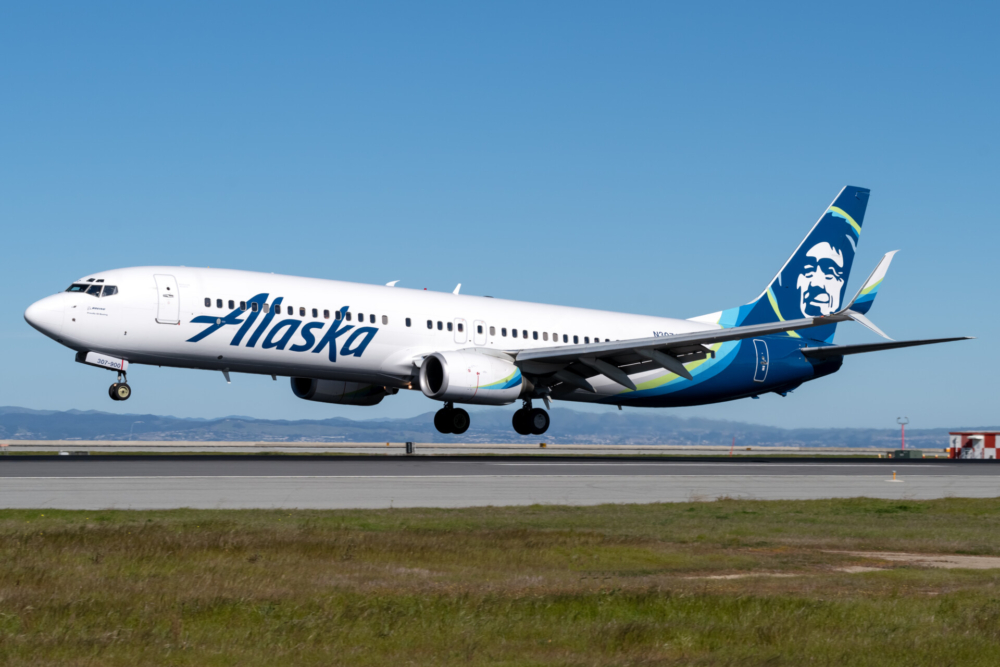Alaska Airlines filed schedule changes for 2022 this weekend. The airline is making progress on growing its schedule depth, a publicly-stated goal from the airline over the next few years. Designed to bolster both its connections and those of its oneworld partners, the airline has added frequencies on a host of new routes near and far.

Alaska adds more schedule depth
According to data from Cirium, Alaska Airlines has made some notable frequency increases to key destinations across the United States next summer. For example:
- Seattle (SEA) to Atlanta (ATL) grows to four daily flights on a Boeing 737-900ER
- Seattle (SEA) to Washington-Dulles (IAD) grows to three daily flights on a Boeing 737-900ER
- Seattle (SEA) to Kansas City (MCI) grows to three daily flights on a Boeing 737-900ER
- Los Angeles (LAX) to Washington-Dulles (IAD) grows to two daily flights on Boeing 737-900ERs
- Boise (BOI) to Chicago (ORD) grows to two daily flights on Embraer E175s
- Portland (PDX) to Boston (BOS) will grow to two daily flights on Boeing 737-900ERs
- San Francisco (SFO) to Honolulu (HNL) will grow to two daily flights on Boeing 737-800s and -900ERs
- San Francisco (SFO) to Las Vegas (LAS) will grow to five daily flights with a mix of Embraer E175s and Airbus A320s operating
- Seattle (SEA) to Fairbanks (FAI) grows to six daily flights on Boeing 737-700, 800s, and -900ERs
There were also notable increases on some shorter-haul routes. This includes growth on Seattle (SEA) to San Jose (SJC) to eight daily flights and Portland (PDX) to Sacramento (SMF) to four daily flights.

A major goal for Alaska Airlines
Alaska Airlines has publicly stated that one of its goals over the next few years regarding its network is to build out its schedule depth. At the Future Flying Forum, Brett Catlin, Alaska’s Vice President of Network and Alliances, stated the following on the airline’s plans:
“We’re squarely focused, to your question, on building depth, not only here in Seattle, but also in markets like San Francisco, Los Angeles, Portland – even up in the state of Alaska. Specifically here in Seattle, what we’re doing and what you’ll already see on our schedules next summer, is we’re trying to get every market up to at least two flights a day. That will take time, particularly with transcon flying that is intensive in terms of aircraft utilization and crew hours.”

Major cities, including Cincinnati, Columbus, Pittsburgh, Indianapolis, and Raleigh, according to Mr. Catlin, will all operate twice daily, for example. However, those are some smaller routes from a daily passenger count. On other routes, namely business centers like Boston, Atlanta, or Washington D.C., the airline needs to get to even more daily flights to meet various traffic flows.
San Francisco to Honolulu is an example of a leisure-oriented route that is growing in depth. While this may seem strange, it is important to note that Alaska will be offering connections on this route with its oneworld partners. In addition, in San Francisco, the airline is making a greater play for originating traffic and staking its claim in the United-dominated airport. Having a competitive schedule in these markets is vital to win over and retain loyalty.

Another interesting route is Boise to Chicago. In this case, Boise is not a middle connecting point, like Seattle or San Francisco. Instead, it is a major originating market for Alaska Airlines that will primarily feed into the American Airlines connecting network in Chicago, offering a better east-west traffic flow than a circuitous routing back towards Seattle first.
Why schedule depth matters
Mr. Catlin explained why schedule depth is important at the Future Flying Forum. Continuing with the examples of Cincinnati, Columbus, etc., he stated:
“We think with the feed network here in Seattle, being at two daily allows us , one, to feed our own domestic network, but, two, to offer a much more compelling proposition to our oneworld members. To give you a specific example, next summer, we’ll operate Orlando three times a day. For the first time that flight will connect in both directions very cleanly with Japan Airlines’ service to Tokyo. And of course, Tokyo to Orlando is a large O&D market, no nonstop service. So when we think about developing the Seattle hub, it’s definitely about feeding those international long-haul services. And we’re trying to recruit new carriers to Seattle all the time, and having a network as a key piece of that.”

In short, schedule depth leads to more benefits for consumers. Alaska can fill more seats on its planes thanks to connections to and from international partners, but it can also continue to strengthen its domestic network. The added schedule depth Alaska Airlines is building in is a central tenet of its strategy to grow its national brand presence while benefiting its partners in the oneworld alliance.
from Simple Flying https://ift.tt/3cWLgxW
via IFTTT
Comments
Post a Comment